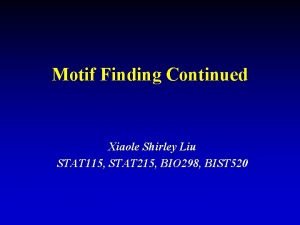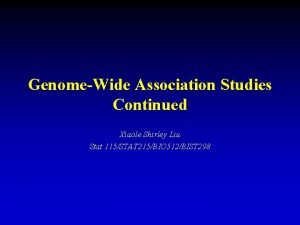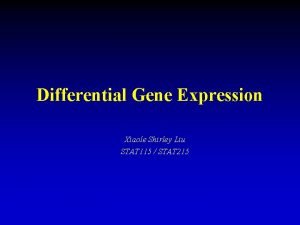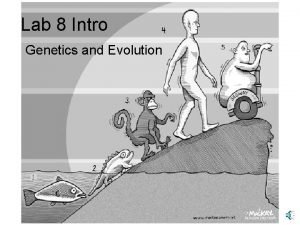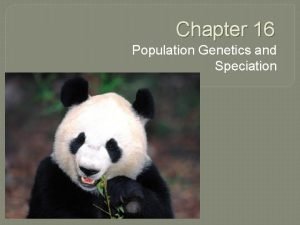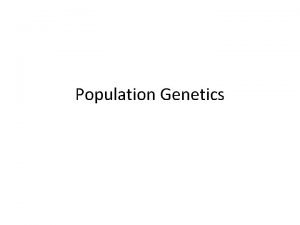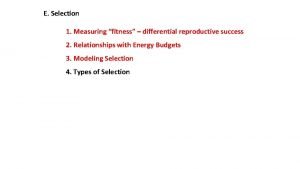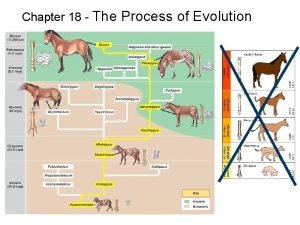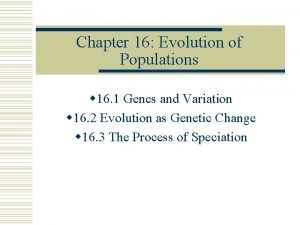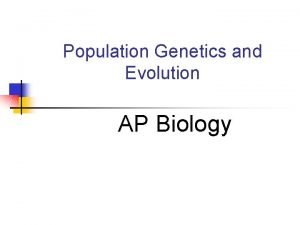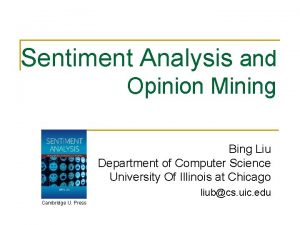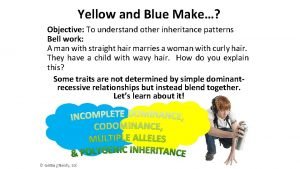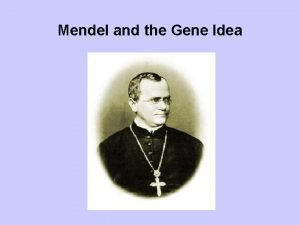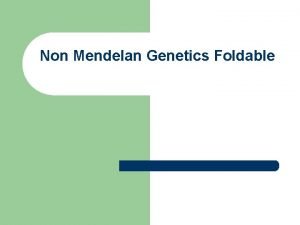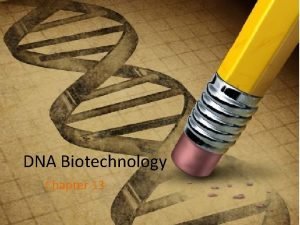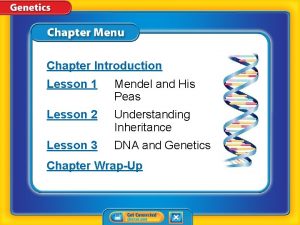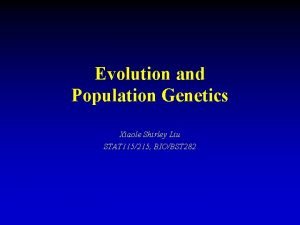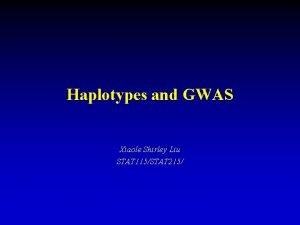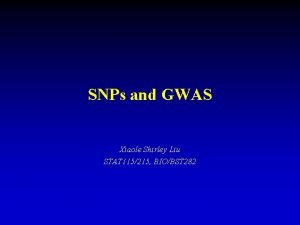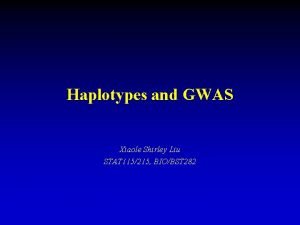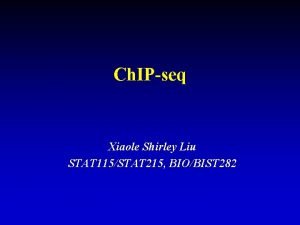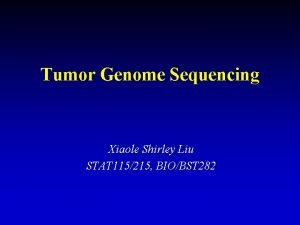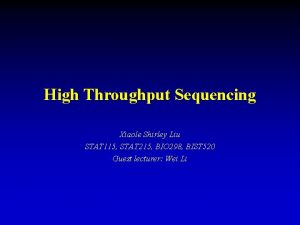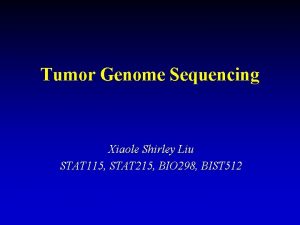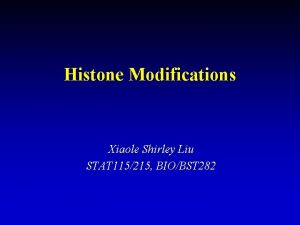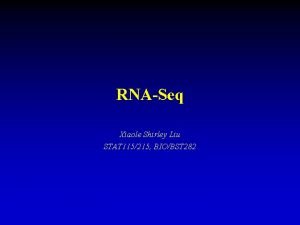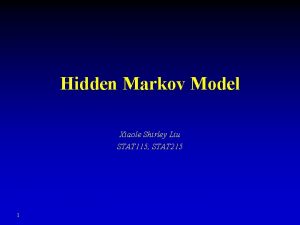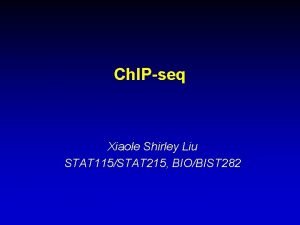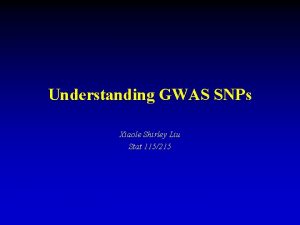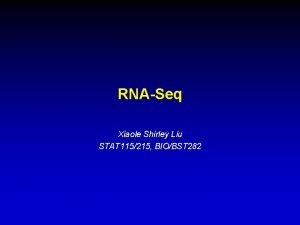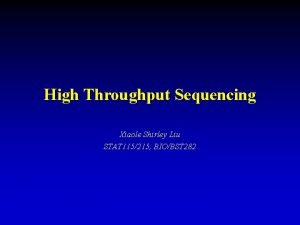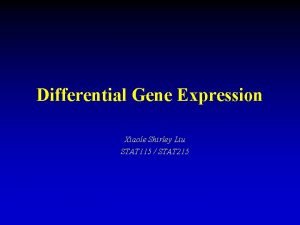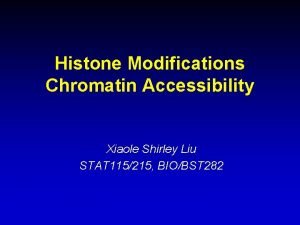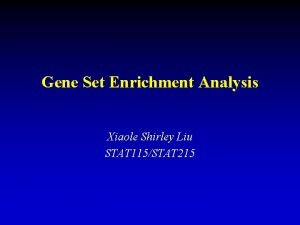Evolution and Population Genetics Xiaole Shirley Liu STAT































- Slides: 31

Evolution and Population Genetics Xiaole Shirley Liu STAT 115 / STAT 215

Evolution • Evolution is a gradual change in genetic makeup from one generation to the next • Evolution: Nonrandom • Natural Selection process • Mutation Random • Genetic Drift processes … • Natural selection and genetic drift are the two most important causes of allele substitution in populations 2

Evolution • Evolution creates species-specific and population-specific differences • Are they all selected for advantages to the species or population? Some definitions: • Locus: position on chromosome where a sequence or a gene is located • Allele: alternative form of DNA on a locus • Written as A vs a, or A vs B 3

Natural Selection What about transgenerational epigenetic inheritance? Controversial 4

Phenotypic vs Molecular Evolution • Phenotypic evolution is controlled by natural selection • Molecular mutations are selectively neutral in the strict sense as that their fate in evolution is largely determined by random genetic drift • Genetic drift due to sampling errors 5 Motoo Kimura

Random Fluctuation in Allele Frequencies Metapopulation Deme p q Neutral alleles p' pt … time Drunk traveler staggering on a train platform with tracks on both sides… will eventually fall off the edge of the platform onto one or the other track 6

Genetic Drift Metapopulation Deme p q Neutral alleles p' pt … time • Over time, allele frequency in each sub-population will fluctuate, diversity in each sub-population will decrease till an allele is fixed (100%) or lost (0%) 7

Factors Influencing Genetic Drift • Deme: a population consisting of closely related species that can typically breed within • Initial mutation (allele) occurs in a deme of N individuals (effective population size) • Assuming neutral evolution, its probably of being sampled in the offspring is 1/2 N • The likelihood of a mutation being fixed is its initial frequency (1 / 2 N): smaller population, more likely fix; larger population more likely lost • Founder effect: new colony starts from few members (small N) of initial population 8

Factors Influencing Genetic Drift • An allele’s probability of fixation equals its frequency at that time and is not affected by its previous history • In a diploid population, the average time to fixation of a newly arisen neutral allele that does become fixed is 4 N generations: evolution by genetic drift proceeds faster in small than in large populations p' • Bottleneck: drastic population decrease for at least one generation accelerate fixation 9

Factors Influencing Genetic Drift • Initially genetically identical demes can evolve by chance to have different genetic constitutions • Pb (mutation X will fix) = allele frequency • Among genetically identical demes in a metapopulation, average allele frequency does not change but heterogeneity in each declines to 0 Metapopulation Deme p q Neutral alleles p' pt … 10

The Neutral Theory of Molecular Evolution • Most mutations (genetic variations) are fixed from genetic drifts: neutrally selected and lacks adaptive significance • Some mutations are disadvantageous and eliminated • Only minority of mutations are advantageous and fixed from natural selection 11 Break

By comparing DNA changes among populations we can trace their history Population 1: Population 2: Population 3: Population 4: 1 ATGTAACGTTATA ACGAAACGTTATA ACGAAACCTTATA 2 3 4

From Phylogeny to Selection • The protein-coding portion of DNA has synonymous and nonsynonymous substitutions. Thus, some DNA changes do not have corresponding protein changes. • If the synonymous substitution rate (d. S) is greater than the nonsynonymous substitution rate (d. N), the DNA sequence is under negative (purifying) selection. • If d. S < d. N, positive selection occurs. E. g. a duplicated gene may evolve rapidly to assume new functions. 13

Molecular Clock • Molecular evolutionary substitutions proceed at ~constant rate, sequence difference between species a molecular clock • If sequences evolve at constant rates (big if), they can be used to estimate the times that sequences diverged. ~Dating fossils by radioactive decay. 14

Molecular Clock • L = number of nucleotides compared between two sequences • N = total number of substitutions • K = N / L, number of substitutions per nucleotide • E. g. K = 0. 093 for rat versus human • r = rate of substitution (mutations) = 0. 56 x 10 -9 per site per year • r = K / 2 T T =. 093 / (2)(0. 56 x 10 -9) = 80 million years 15 Graur and Li (1999)

Factors Influencing Mutation Rate / Molecular Clock • Generation time (age to reproduction) • Population size (stronger drifts in small populations) • Intensity of natural selection • Species-specific differences When two species are way too different, over a sufficiently long time some sites experience repeated base substitutions, so the observed number of differences will plateau. 16

Factors Influencing Mutation Rate / Molecular Clock • Generation time (age to reproduction) • Population size (stronger drifts in small populations) • Intensity of natural selection • Species-specific differences • Change in protein function 17

Constant Mutation Rate? Page & Holmes

Where did we come from? • Two competing hypotheses – Multiregional evolution (1 millions years ago, Homo erectus left Africa, and evolve into modern humans in different parts of the Old World) – The Out of Africa hypothesis: Homo erectus were displaced by new populations of modern humans that left Africa 100 K to 50 K years ago.

• National Geographic Story Jan 2014 • If a fragment of DNA is shared by Neanderthals and non-Africans, but not Africans or other primates, it is likely to be a Neanderthal heirloom. • People living outside Africa carries 1 -4% of Neanderthal DNA (skin, hair, etc). 20 Break

Polymorphism • Polymorphism: sites/genes with “common” variation, less common allele frequency >= 1%, otherwise called rare variant and not polymorphic • Single Nucleotide Polymorphism – Come from DNA-replication mistake individual germ line cell, then transmitted – ~90% of human genetic variation • Copy number variations – May or may not be genetic 21 STAT 115

Why Should We Care • Disease gene discovery – Association studies, e. g. certain SNPs are susceptible for diabetes – Chromosome aberrations, duplication / deletion might cause cancer • Personalized Medicine – Drug only effective if you have one allele 22 STAT 115

SNP Distribution • Most common, 1 SNP / 100 -300 bp – Balance between mutation introduction rate and polymorphism lost rate – Most mutations lost within a few generations • 2/3 are CT differences • In non-coding regions, often less SNPs at more conserved regions • In coding regions, often more synonymous than non-synonymous SNPs 23 STAT 115

SNP Characteristics: Allele Frequency Distribution • Most alleles are rare (minor allele frequency < 10%) 24 STAT 115

SNP Characteristics: Linkage Disequilibrium • Hardy-Weinberg equilibrium – In a population with genotypes AA, aa, and Aa, if p = freq(A), q =freq(a), the frequency of AA, aa and Aa will be p 2, q 2, and 2 pq respectively at equilibrium. – Similarly with two loci, each two alleles Aa, Bb 25 STAT 115

SNP Characteristics: Linkage Disequilibrium • Equilibrium Disequilibrium 0. 26 ab • LD: If Alleles occur together more often than can be accounted for by chance, then indicate two alleles are physically close on the DNA – In mammals, LD is often lost at ~100 KB – In fly, LD often decays within a few hundred bases 26 STAT 115

SNP Characteristics: Linkage Disequilibrium • Statistical Significance of LD – Chi-square test (or Fisher’s exact test) – eij = ni. n. j / n. T 27 B 1 B 2 Total A 1 n 12 n 1. A 2 n 21 n 22 n 2. Total n. 1 n. 2 n. T STAT 115

SNP Characteristics: Linkage Disequilibrium • Haplotype block: a cluster of linked SNPs • Haplotype boundary: blocks of sequence with strong LD within blocks and no LD between blocks, reflect recombination hotspots 28 STAT 115

SNP Characteristics: Linkage Disequilibrium • Haplotype block: a cluster of linked SNPs • Haplotype boundary: blocks of sequence with strong LD within blocks and no LD between blocks, reflect recombination hotspots • Haplotype size distribution 29 STAT 115

Summary • Phenotype evolution (natural selection) vs molecular evolution (neutral theory) • Decrease of genetic variation over time • Fixation: population size, probability • Positive and negative selection (d. N / d. S ratio) • Molecular clock and migration patterns • Genome variations: SNP and CNV • Linkage disequilibrium from recombination 30

Acknowledgement • Francisco Ubeda • Jun Liu 31
 Agtcc
Agtcc Xiaole liu
Xiaole liu Xiaole liu
Xiaole liu Similar
Similar Alex liu cecilia liu
Alex liu cecilia liu Líu líu lo lo ta ca hát say sưa
Líu líu lo lo ta ca hát say sưa Population genetics and speciation worksheet answer key
Population genetics and speciation worksheet answer key Linkage disequilibrium definition
Linkage disequilibrium definition Modern synthesis
Modern synthesis The far side comics
The far side comics Population genetics
Population genetics Population genetics definition
Population genetics definition Chapter test a chapter 4 population ecology answer key
Chapter test a chapter 4 population ecology answer key Population ecology section 1 population dynamics answer key
Population ecology section 1 population dynamics answer key Population ecology section 1 population dynamics
Population ecology section 1 population dynamics Population ecology section 1 population dynamics answer key
Population ecology section 1 population dynamics answer key Cornelia m ruland
Cornelia m ruland Lucy liu with my girl drew cameron d
Lucy liu with my girl drew cameron d Sentiment analysis and opinion mining bing liu
Sentiment analysis and opinion mining bing liu Getting nerdy llc genetics you're such a square answer key
Getting nerdy llc genetics you're such a square answer key Sexual reproduction and genetics section 1 meiosis
Sexual reproduction and genetics section 1 meiosis Pedigree miscarriage symbol
Pedigree miscarriage symbol Multiplication and addition rule genetics
Multiplication and addition rule genetics Human genetics concepts and applications 10th edition
Human genetics concepts and applications 10th edition Genes is the study of heredity and variation
Genes is the study of heredity and variation Chapter 22 genetics and genetically linked diseases
Chapter 22 genetics and genetically linked diseases Sexual reproduction and genetics section 1 meiosis
Sexual reproduction and genetics section 1 meiosis Chromosomes genes and basic genetics foldable answer key
Chromosomes genes and basic genetics foldable answer key Chapter 10 sexual reproduction and genetics
Chapter 10 sexual reproduction and genetics Pap protein synthesis worksheet
Pap protein synthesis worksheet Genetics and biotechnology chapter 13
Genetics and biotechnology chapter 13 Solid
Solid
